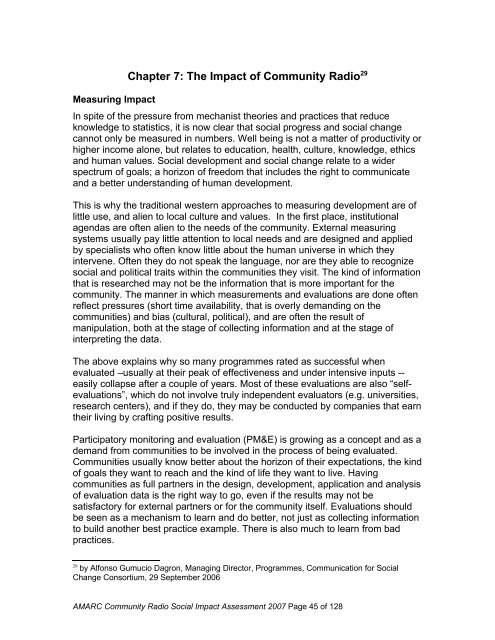Removing Barriers, Increasing Effectiveness - amarc
Removing Barriers, Increasing Effectiveness - amarc
Removing Barriers, Increasing Effectiveness - amarc
You also want an ePaper? Increase the reach of your titles
YUMPU automatically turns print PDFs into web optimized ePapers that Google loves.
Measuring ImpactChapter 7: The Impact of Community Radio 29In spite of the pressure from mechanist theories and practices that reduceknowledge to statistics, it is now clear that social progress and social changecannot only be measured in numbers. Well being is not a matter of productivity orhigher income alone, but relates to education, health, culture, knowledge, ethicsand human values. Social development and social change relate to a widerspectrum of goals; a horizon of freedom that includes the right to communicateand a better understanding of human development.This is why the traditional western approaches to measuring development are oflittle use, and alien to local culture and values. In the first place, institutionalagendas are often alien to the needs of the community. External measuringsystems usually pay little attention to local needs and are designed and appliedby specialists who often know little about the human universe in which theyintervene. Often they do not speak the language, nor are they able to recognizesocial and political traits within the communities they visit. The kind of informationthat is researched may not be the information that is more important for thecommunity. The manner in which measurements and evaluations are done oftenreflect pressures (short time availability, that is overly demanding on thecommunities) and bias (cultural, political), and are often the result ofmanipulation, both at the stage of collecting information and at the stage ofinterpreting the data.The above explains why so many programmes rated as successful whenevaluated –usually at their peak of effectiveness and under intensive inputs --easily collapse after a couple of years. Most of these evaluations are also “selfevaluations”,which do not involve truly independent evaluators (e.g. universities,research centers), and if they do, they may be conducted by companies that earntheir living by crafting positive results.Participatory monitoring and evaluation (PM&E) is growing as a concept and as ademand from communities to be involved in the process of being evaluated.Communities usually know better about the horizon of their expectations, the kindof goals they want to reach and the kind of life they want to live. Havingcommunities as full partners in the design, development, application and analysisof evaluation data is the right way to go, even if the results may not besatisfactory for external partners or for the community itself. Evaluations shouldbe seen as a mechanism to learn and do better, not just as collecting informationto build another best practice example. There is also much to learn from badpractices.29by Alfonso Gumucio Dagron, Managing Director, Programmes, Communication for SocialChange Consortium, 29 September 2006AMARC Community Radio Social Impact Assessment 2007 Page 45 of 128
















